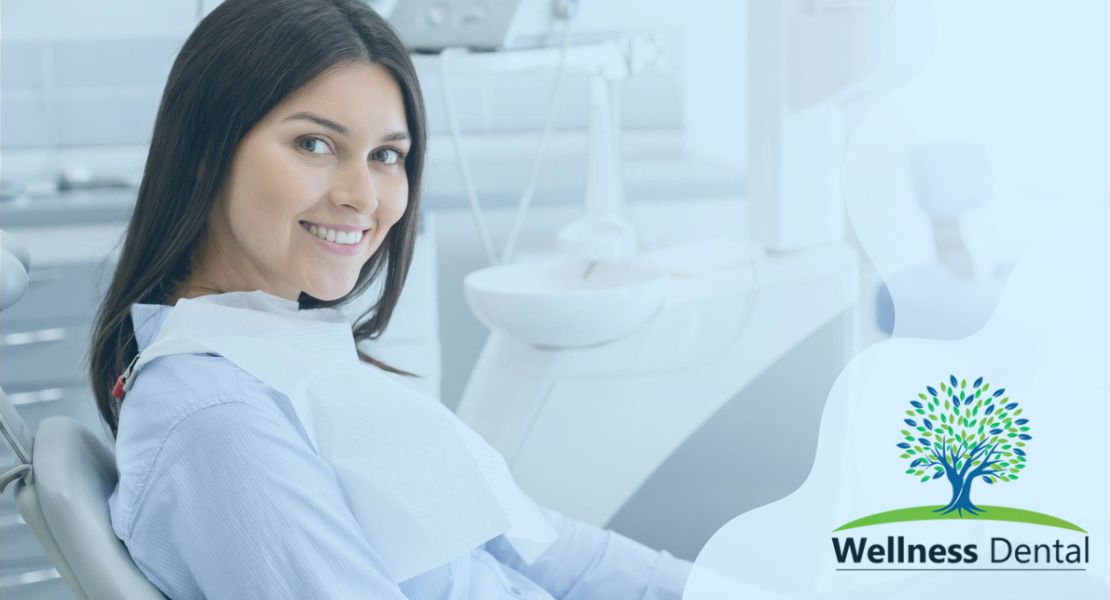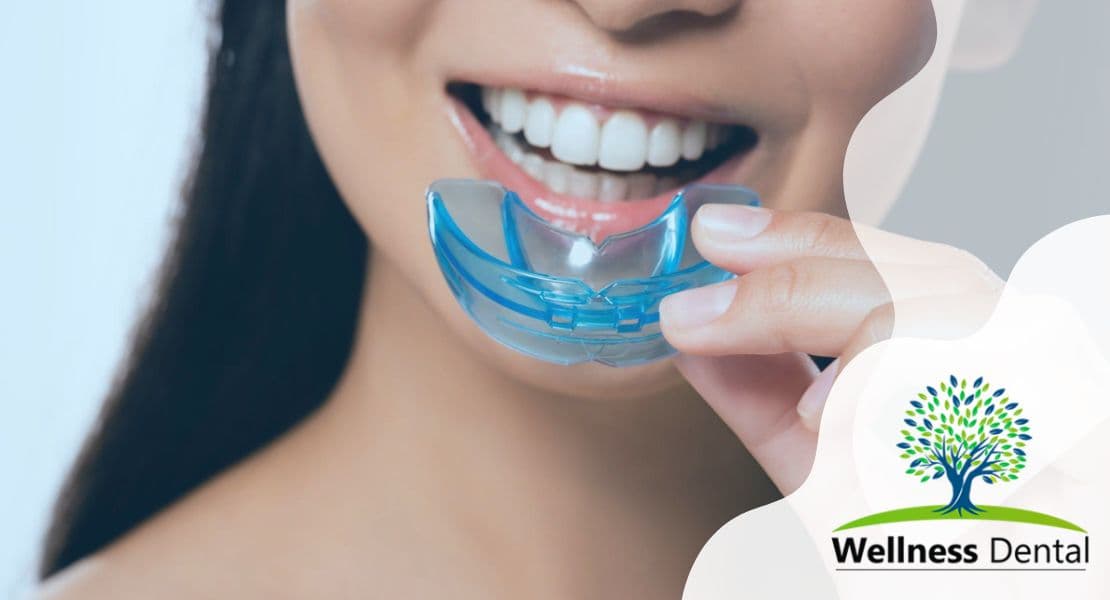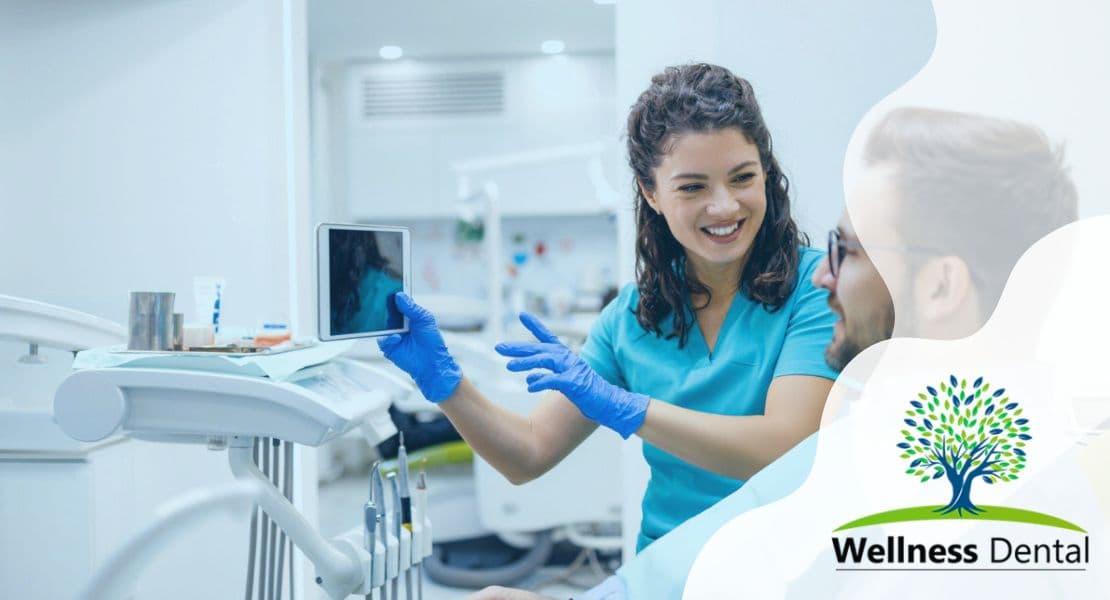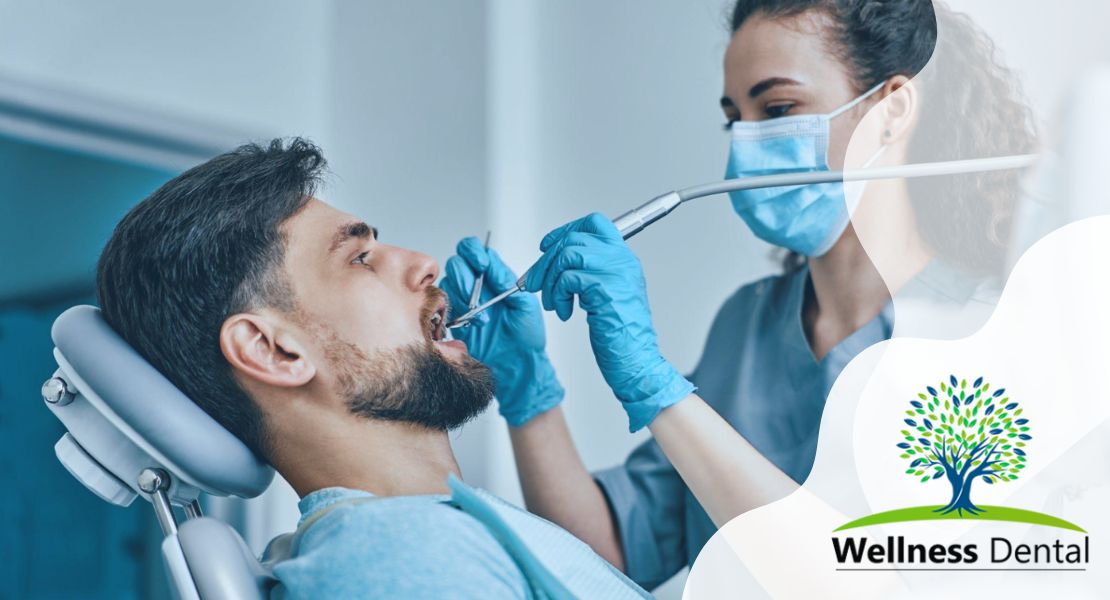What are Tooth Stains?
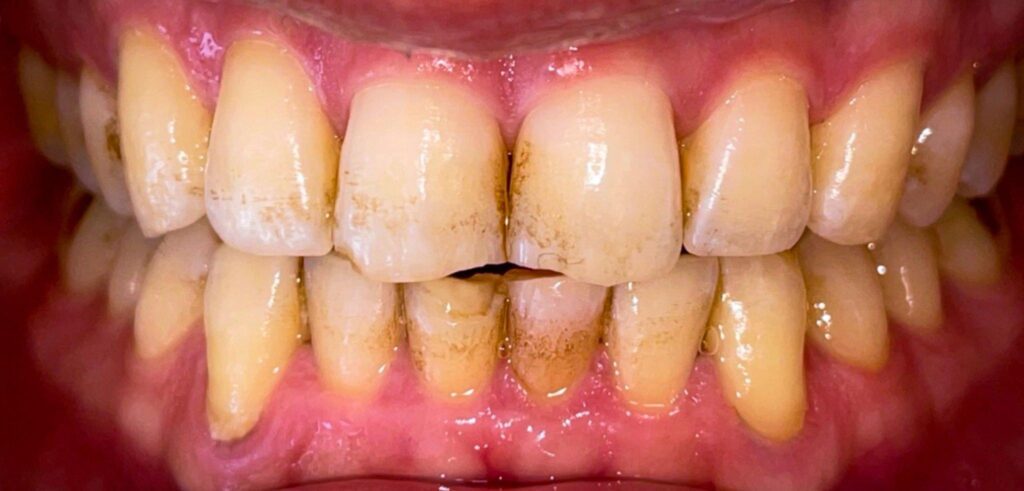
Tooth stains are discolorations or markings on the surface or inner layer of the teeth that affect the natural color and appearance of our smiles. They can be caused by various factors, including certain foods and drinks, tobacco use, poor dental hygiene, aging, and even medical treatments. There are two main types of tooth stains: extrinsic stains and intrinsic stains.
Extrinsic stains occur on the outer layer of the teeth, known as tooth enamel, and are typically caused by external factors such as food and drink stains or the use of tobacco products. Intrinsic stains, on the other hand, occur within the inner layer of the teeth and can be caused by various factors such as tooth trauma, excessive fluoride during tooth development, certain medications, or even aging. Now, let’s take a closer look at these types of teeth stains and explore available treatment options for achieving a brighter, whiter smile.
Types of Tooth Stains

Tooth staining is a common dental concern that can affect the appearance of our teeth. There are different types of tooth stains, including extrinsic stains, intrinsic stains, and age-related stains.
Extrinsic stains are superficial stains that occur on the outer layer of the tooth, known as the enamel. These stains are typically caused by external factors such as coffee, tea, red wine, tobacco, and certain foods. Extrinsic stains can range in color from yellow to brown and can be effectively treated with professional teeth cleaning and at-home whitening products.
Intrinsic stains, on the other hand, occur within the tooth and are often caused by factors like tooth decay, excessive fluoride use during tooth development, or certain medications. Intrinsic stains are usually more difficult to remove and may require dental treatments such as professional whitening or veneers to improve the appearance of the teeth.
Age-related stains are a combination of extrinsic and intrinsic factors and occur naturally as we get older. As we age, the outer layer of enamel becomes thinner, allowing the underlying yellowish dentin to show through, leading to a duller appearance of the teeth.
Maintaining good oral hygiene, avoiding stain-causing substances, and regular dental cleanings can help prevent tooth staining. Additionally, there are various treatment options available to address different types of tooth stains and restore a brighter smile.
By understanding the different types of tooth stains and their causes, individuals can take appropriate measures to maintain their oral hygiene and preserve a beautiful, white smile.
Extrinsic Stains
Extrinsic stains are a common dental issue that can greatly impact the appearance of our teeth. These types of stains occur on the outer layer of the tooth, known as the enamel. They are often caused by external factors such as consuming beverages like coffee, tea, and red wine, as well as using tobacco and eating certain foods. Extrinsic stains can range in color from yellow to brown and can be quite noticeable, leading to a less-than-ideal smile.
Fortunately, there are various options available to effectively treat extrinsic stains. Professional teeth cleanings can help remove surface stains, while at-home whitening products can help brighten the teeth and restore their natural color. By taking steps to avoid stain-causing substances and practicing good oral hygiene, it’s possible to prevent or minimize the occurrence of extrinsic stains and maintain a beautiful, bright smile.
Causes of Extrinsic Stains
One of the primary causes of extrinsic stains is the consumption of certain foods and drinks. Dark-colored beverages such as coffee, tea, and red wine can stain the teeth over time. Additionally, foods that contain artificial food colorings, such as candies and colored sodas, can also contribute to extrinsic stains.
Smoking is another major cause of extrinsic stains. The chemicals in tobacco can discolor the teeth, leaving them yellow or brown. This discoloration can be challenging to remove and often requires professional teeth whitening treatments.
Interestingly, some antibiotics, such as tetracycline, can also cause extrinsic stains. These medications can affect the development of tooth enamel, leading to discoloration. It is important to mention this link to your dental professional if you have taken antibiotics in the past.
To prevent extrinsic stains, it is essential to practice good oral hygiene. Regular dental cleanings, brushing twice a day, and flossing can help remove surface stains and maintain a brighter smile. If extrinsic staining occurs, professional teeth whitening treatments or over-the-counter whitening products can be effective in restoring the natural color of the teeth.
Treating Extrinsic Stains
When it comes to addressing extrinsic stains on your teeth, there are several treatment options available. One of the most effective ways to remove these stains is through professional teeth whitening treatments. These treatments are typically done in-office by a dental professional and use high-concentration bleaching agents to eliminate surface stains and brighten your smile. They are known to provide more immediate and noticeable results compared to over-the-counter whitening products.
Regular brushing and flossing are also essential in reducing plaque buildup, which can contribute to extrinsic stains. Brushing at least twice a day and flossing daily can help remove food particles and bacteria that can cause stains over time. Additionally, maintaining good oral hygiene practices can prevent other dental issues such as tooth decay and gum disease.
Another option for treating extrinsic stains is using whitening toothpaste or gel. These products contain mild abrasives and special chemicals that can help remove surface stains on the teeth. While they may not provide the same dramatic results as professional treatments, they can gradually lighten the color of your teeth and improve their overall appearance when used consistently.
In summary, the treatment options for extrinsic stains include professional teeth whitening treatments, regular brushing and flossing to reduce plaque buildup, and using whitening toothpaste or gel. By following these practices, you can maintain a bright and beautiful smile free from unsightly extrinsic stains.
Intrinsic Stains
Intrinsic stains refer to discoloration that occurs within the inner layer of the tooth, known as the dentin. Unlike extrinsic stains, which are caused by external factors such as food and drink, intrinsic staining is typically the result of factors within the body, such as medication use, trauma, or excessive fluoride during tooth development. Intrinsic stains can also be caused by genetic factors or natural aging processes.
This type of staining is often more challenging to treat compared to extrinsic stains. However, there are still options available to help improve the appearance of intrinsic stains. Dental treatments such as professional whitening, dental bonding, and veneers can often be effective in reducing the appearance of intrinsic stains and restoring a brighter smile. It’s important to consult with a dental professional to determine the most appropriate treatment option for your specific case of intrinsic staining.
Causes of Intrinsic Stains
Intrinsic stains are a type of teeth discoloration that occurs within the inner structure of the tooth. Unlike extrinsic stains that affect the outer layer of the tooth enamel, intrinsic stains are caused by various internal factors.
One common cause of intrinsic stains is antibiotic use. Certain antibiotics, such as tetracycline and doxycycline, can cause discoloration of the teeth if taken during tooth development in childhood. This is because these medications can bind to the mineral structure of the developing teeth, leading to permanent staining.
Excessive exposure to fluoride, either through fluoridated water or from other sources, can also cause intrinsic staining. High levels of fluoride can disrupt the formation of the tooth enamel, causing it to become discolored.
As we age, the tooth enamel naturally thins, making the underlying dentin more visible. This can result in a yellow or brownish appearance of the teeth.
Intrinsic stains can also be influenced by genetic factors. Some individuals may be more prone to developing certain types of tooth discoloration due to genetic predisposition.
Lastly, certain individuals may have intrinsic stains present before their teeth even erupt. These stains can occur during tooth development in the womb and may be influenced by maternal factors or the child’s overall health.
It’s important to note that intrinsic stains require professional treatment options as they cannot be removed with regular dental hygiene practices. If you’re experiencing intrinsic staining, consult with a dental professional to explore whitening or other suitable treatment options to restore a brighter smile.
Treatments for Intrinsic Stains
When it comes to addressing intrinsic stains on the teeth, there are various treatment options available that can help restore a brighter smile. One popular method is professional teeth whitening, which is performed by a dental professional. This treatment involves the use of a bleaching agent, such as hydrogen peroxide or carbamide peroxide, to lighten the tooth color.
Professional teeth whitening is highly effective in reducing intrinsic staining. The bleaching solution penetrates the enamel and breaks down the stain molecules, resulting in a whiter smile. This treatment can be customized to suit individual needs and can provide noticeable results in just one session.
Another treatment option for intrinsic stains is laser whitening. This procedure involves the use of a special laser light to activate a whitening gel applied to the teeth. The laser energy enhances the effectiveness of the whitening gel, helping to eliminate stubborn stains.
Both professional teeth whitening and laser whitening have their benefits and considerations. While they are effective in treating intrinsic stains, it is important to note that results may vary depending on the severity of the staining. Additionally, some individuals may experience tooth sensitivity as a common side effect of these treatments, but this is temporary and usually subsides.
In conclusion, professional teeth whitening and laser whitening are effective treatments for intrinsic stains. They offer a safe and efficient way to achieve a whiter smile and improve overall tooth color. However, it is recommended to consult with a dental professional to determine the most suitable treatment option based on individual needs and oral health.
Prevention and Treatment Options
Teeth stains can be categorized into two main types: extrinsic stains and intrinsic stains. Extrinsic stains are on the outer layer of the teeth and are typically caused by external factors such as food, beverages, and smoking. On the other hand, intrinsic stains occur within the tooth enamel and are often caused by factors like aging, tooth decay, or excessive fluoride.
Prevention is key when it comes to maintaining a bright and healthy smile. Regular dental cleanings and good oral hygiene practices, such as brushing twice a day and flossing, can help prevent surface stains from developing. Avoiding or limiting the consumption of stain-causing foods and drinks, such as coffee, tea, and red wine, can also be beneficial. Additionally, practicing moderation when it comes to using tobacco products can greatly reduce the risk of tooth discoloration.
When it comes to treatment options, there are various approaches to addressing teeth stains. For extrinsic stains, dental cleanings and professional teeth whitening procedures are often recommended. Dental cleanings remove surface stains and tartar buildup, while professional teeth whitening can provide more dramatic results by using bleaching agents to lighten the tooth color.
For intrinsic stains, treatment options may include professional whitening treatments, laser whitening, or dental treatments like veneers or bonding. These options can help improve the appearance of discolored teeth by targeting the underlying causes of intrinsic staining. It’s important to consult with a dental professional to determine the most suitable treatment plan based on individual needs and the severity of the stains. By addressing teeth stains through proper prevention and treatment, one can achieve a brighter and more confident smile.
Professional Teeth Whitening
Professional teeth whitening is a popular treatment option for addressing surface stains and achieving a brighter smile. In an in-office treatment, hydrogen peroxide or carbamide peroxide is often used to break up and remove these stains.
During a typical in-office whitening session, the first step is to clean the teeth thoroughly. This ensures that any plaque or tartar buildup is removed, allowing the whitening gel to make direct contact with the tooth surface.
Next, the lips and gums are protected with a barrier or a special gel to prevent any irritation or sensitivity. This is an important step to ensure a safe and comfortable experience.
Once the teeth are prepared, the whitening gel is applied to the tooth surfaces. This gel is specially formulated with hydrogen peroxide or carbamide peroxide, which are active ingredients that help to break up and remove surface stains. These bleaching agents work by penetrating the enamel and oxidizing the stains, leaving the teeth looking whiter and brighter.
To enhance the effectiveness of the whitening gel, LED lights are often used to activate the gel. The lights help to accelerate the whitening process, allowing the gel to work more efficiently and effectively.
After the gel has been applied and activated, it is then rinsed off, revealing a noticeably whiter smile. Professional teeth whitening can provide immediate results and can often lighten the tooth color by several shades in just one session.
Overall, in-office professional teeth whitening is a safe and effective treatment option for removing surface stains and achieving a whiter, more radiant smile.
Office Whitening Treatments
Office whitening treatments are a popular choice for removing tooth stains and achieving a brighter, more beautiful smile. These treatments are performed in a dental office and utilize higher concentrations of active ingredients to deliver quicker and more visible results.
During an in-office whitening treatment, a dental professional will first clean the teeth thoroughly to remove any plaque or tartar buildup. This ensures that the whitening gel can make direct contact with the tooth surfaces.
Next, a barrier or special gel is applied to protect the lips and gums from any potential irritation or sensitivity. This step is important to ensure a safe and comfortable experience during the treatment.
The teeth are then coated with a whitening gel that contains high concentrations of hydrogen peroxide or carbamide peroxide. These active ingredients penetrate the enamel and break down surface stains, resulting in a whiter and brighter smile.
To enhance the effectiveness of the whitening gel, additional techniques may be employed, such as the use of LED lights or laser therapy. These techniques help to accelerate the whitening process and achieve even more noticeable results.
In-office whitening treatments offer immediate results and can often lighten the tooth color by several shades in just one session. With the higher concentrations of active ingredients and the use of additional techniques, these treatments provide a fast and effective way to remove tooth stains and achieve a whiter smile.
At-Home Teeth Whitening Kits
At-home teeth whitening kits are a convenient and cost-effective way to achieve a brighter smile in the comfort of your own home. There are several different types of at-home whitening products available, each offering unique benefits and varying levels of effectiveness.
Whitening toothpaste is a popular option among those looking to remove surface stains and maintain a whiter smile. These toothpastes contain mild abrasives that gently polish the teeth, helping to remove extrinsic stains caused by food, beverages, and tobacco. However, it’s important to note that whitening toothpaste can only lighten surface stains and won’t change the natural color of your teeth.
Another option is whitening mouthwash, which contains hydrogen peroxide or carbamide peroxide to help remove stains and brighten teeth. Using a whitening mouthwash after brushing can provide an extra boost to your oral hygiene routine.
Tooth whitening gels are typically applied using a tray that is custom-fitted to your teeth. These gels contain higher concentrations of bleaching agents, allowing them to penetrate the enamel and lighten deeper stains. Whitening strips are thin, flexible strips coated with a peroxide-based gel. They are applied directly to the teeth and left in place for a designated amount of time.
Whitening pens are a convenient option for touch-ups on the go. These pens contain a gel that can be applied directly to the teeth and left to dry. They are easy to use and provide targeted whitening where it’s needed.
It’s important to consider several factors when choosing an at-home teeth whitening kit. These include the concentration of bleaching agents, sensitivity levels, and ease of application. Higher concentrations of bleaching agents may provide faster results but can also increase the risk of sensitivity. It’s essential to follow the instructions carefully and consult with a dental professional if you have any concerns.
Overall, at-home teeth whitening kits can be an effective way to enhance your smile, but it’s important to choose the right product for your needs and use it as directed to minimize the risk of potential side effects.
Dietary Changes to Prevent Tooth Discoloration
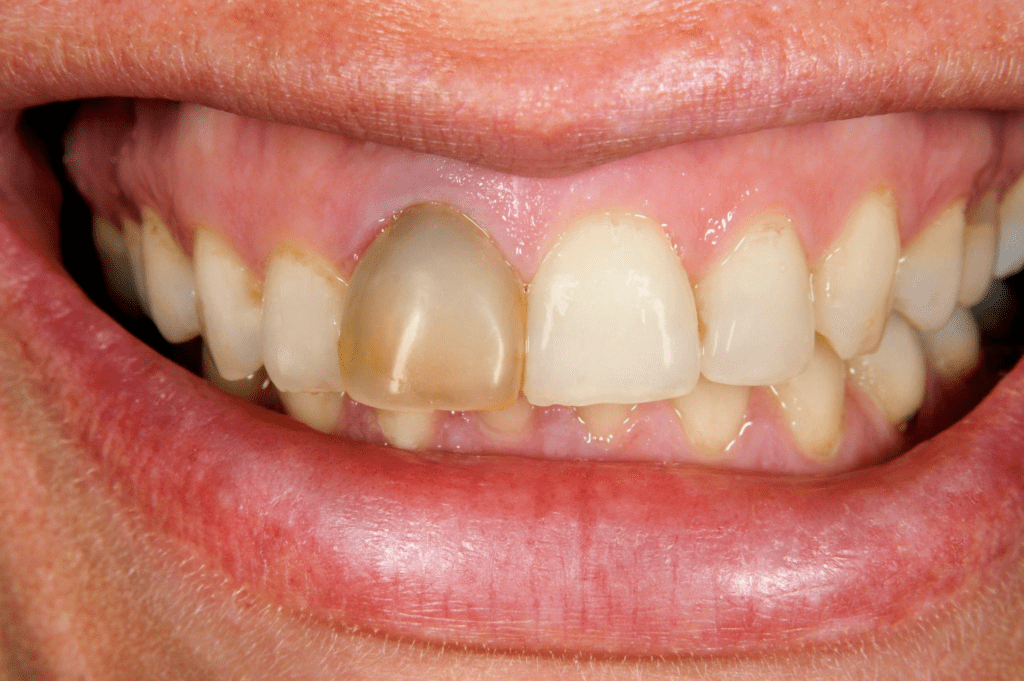
One of the key ways to prevent tooth discoloration is by making dietary changes. Certain foods and beverages can cause stains on our teeth, so it’s important to be mindful of what we consume. Some common stain-causing foods and drinks include coffee, tea, soda, and red wine. Additionally, colorful foods like blueberries, beets, soy sauce, and tomato sauce can also contribute to tooth discoloration.
To prevent teeth discoloration, it can be helpful to make some lifestyle changes. Cutting back on coffee and smoking can significantly reduce the risk of staining. When consuming stain-causing beverages, using a straw can help minimize contact with the teeth. Additionally, maintaining good dental hygiene practices, such as regular brushing, flossing, and dental cleanings, can help prevent teeth discoloration.
By implementing these dietary and lifestyle changes, you can proactively protect your teeth from becoming discolored. However, it’s important to remember that preventive measures can only go so far. If your teeth are already discolored, professional teeth whitening treatments or dental treatments may be necessary to achieve a whiter smile.
By being mindful of what you consume and taking steps to maintain good dental hygiene, you can help prevent tooth discoloration and enjoy a brighter, more beautiful smile.
Factors Affecting Treatment Outcomes
When it comes to treating teeth stains, there are several factors that can influence the effectiveness of the treatment and the final outcome. One of the key factors is the type of teeth stain. Teeth stains can be categorized as either extrinsic or intrinsic. Extrinsic stains occur on the outer layer of the teeth, known as the tooth enamel, and are usually caused by external factors like food, beverages, and tobacco. Intrinsic stains, on the other hand, occur beneath the enamel, within the tooth, and are often caused by factors such as trauma, aging, or excessive fluoride intake during tooth development.
The severity of the stains also plays a role in treatment outcomes. Surface stains that only affect the outer layer of the teeth can usually be effectively removed through professional teeth cleanings or using over-the-counter whitening products. However, deeper and more stubborn stains may require more intensive treatments, such as office whitening procedures or dental treatments like veneers or bonding.
Another factor that can impact treatment outcomes is the overall oral hygiene of the individual. Good dental hygiene practices, such as regular brushing and flossing, can help prevent and reduce surface stains. However, if oral hygiene is neglected, stains may be more difficult to remove and may reoccur more quickly.
It is important to note that individual responses to treatment can vary. Factors such as the thickness and quality of the enamel, tooth color, and even genetic predispositions can influence how effective a treatment will be in achieving a whiter, brighter smile. Consulting with a dental professional is crucial to assess the specific type of stain and determine the most suitable treatment options for the individual’s unique circumstances.
Outer Layer of the Tooth (Enamel)
The outer layer of the tooth, known as enamel, plays a crucial role in protecting the tooth and maintaining its overall health. Composed mainly of minerals, such as calcium phosphate, enamel is the hardest substance in the human body. Its tough and durable nature allows it to withstand the daily wear and tear of biting, chewing, and grinding.
Enamel serves as a protective barrier that shields the more vulnerable layers of the tooth, such as dentin and pulp, from bacteria, acids, and other harmful substances. It acts as a defense against tooth decay and cavities by preventing the penetration of bacteria and acids into the deeper layers of the tooth structure.
Enamel formation, known as enamelogenesis, occurs during early tooth development. Specialized cells called ameloblasts produce and deposit the mineralized enamel matrix, which gradually hardens and becomes the enamel we see on the surface of our teeth. However, the formation of enamel is a one-time process and does not continue throughout our lives.
Several factors can contribute to the erosion or damage of enamel. These include poor oral hygiene habits, such as infrequent brushing or excessive consumption of acidic foods and beverages. Additionally, tooth grinding, acid reflux, and certain medical conditions can also wear down enamel over time.
Maintaining the health of the enamel is essential for overall oral health. Regular brushing and flossing, along with routine dental visits for professional cleanings and check-ups, are crucial to preserving the integrity of the enamel. Dental treatments, such as fluoride application and dental sealants, can also help protect and strengthen enamel, reducing the risk of damage and decay.

